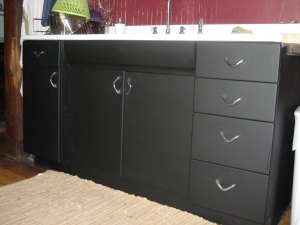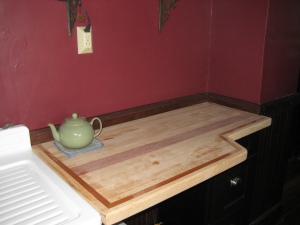It’s a bad sign when your own browser history doesn’t remember your blog. Nevertheless, I shall proceed with a review.
Currently, I am whiling away the summer (but also reading prodigiously) in Barcelona. My two lovely friends, Minnie and Earthwalker, were able to visit me, and we indulged in some delicious meals (I’ll do another post with recaps and links), the best of which was at Restaurant U in Avinyonet in the Penedes. This was part of a day trip to explore the cava vineyards. (We hired a car, and we visited Freixenet and Pares Balta. So so worth it.)*
The highlight of the trip was definitely lunch, however. After our tour at Freixenet, we made our way to the small village of Avinyonet. A wee bit of excitement and misdirection (see below for detailed instructions; thanks, lovely construction workers, for lifting our small egg-shaped car out of the abyss) later, we arrived to find Raimondo, the owner/chef, getting ready to close up for the afternoon siesta. He very graciously welcomed us in, and he just as graciously offered to explain the (very reasonably priced) menu del dia. Since we were the only people there, Earthwalker asked him to make us whatever he felt like. (I had read several glowing reviews, and I felt slightly bad about showing up relatively late. Even for a Spanish lunch.)
That, my friends, was an excellent idea. Raimondo treated us to, basically, one of his evening tasting menus, accompanied by a private history of Catalan cooking and the producers involved in the local food movement. All of his dishes are based on 13th century Catalan cook books, using the best possible produce– and only produce that would have been available in 13th century Catalunya. This means that some of the iconic dishes of Catalan food– pan amb tomaquet, for example– aren’t part of the menu, because tomatoes– along with corn, sweet peppers, and chocolate– are indigenous to North and South America. Very briefly shown to students in cooking schools, facsimiles of these cookbooks are the basis of modern Catalan cuisine, but they don’t get much attention otherwise. Raimondo has excavated them and adapted them to contemporary tastes. (The food nerd in me was in heaven.)
He also guided us to an excellent bottle of Pardas Xarel.lo 2007, from a wine list comprised entirely of Catalan wines. Xarel.lo is one of the three grapes that combine to make cava.
Raimondo and his sister share kitchen duty, and they are both clearly guided by a dedication to Catalan cooking and a passion for delicious food. He was so excited to tell us about how and why he cooked the way he does, and he eagerly answered all my questions (while Minnie and Earthwalker patiently observed my geekery).
The menu:
An amuse bouche of bruschetta topped with hummus.
Appetizer of herb-filled flat bread with a saffron dipping sauce. The dipping sauce was slightly foamy and tangy (like a loose creme fraiche), and it very nicely complemented the salty freshness of the bread.
Appetizer of “shrimp popsicle”: four shrimp nestled into two circles, perfectly grilled with an amazing (amazing) soy and arugula-oil dipping sauce. Seriously, at one point Raimondo wanted to take the sauce away because he thought I was “finished.” I may have growled at him.
Pickled partridge salad: incredibly tender and moist shreds of partridge with mixed greens.
Cod: The perfectly cooked (ginormous) cod on a bed of softly stewed vegetables (eggplant, onions, ?), with a creamy, slightly sweet almond milk sauce. Raimondo mentioned that this was one of the dishes he had tweaked a bit from the 13th century recipe to accommodate contemporary palates, which are not as comfortable combining savory and sweet.
Suckling pig: A mound of suckling pig contained by its robe of jamon, over a chutney of onions and apples. Let me pause to say, the portions were not “tasting” portions.
Dessert: “chocolate” cake with whipped marscapone. Except made with carob. Um, I take back every mean or skeptical thing I ever said about vegan cookies (although I do doubt they could be this delicious). The carob yielded a not-too-sweet, slightly fruity flavor– the kind of flavor I associate with fancy dark chocolate bars– but it was pleasantly (relatively) light after such a generous meal.
This was an amazing meal, and I encourage anyone close to Barcelona to make the trip.
Restaurant U
Pare Carles Suria, 13
08793 Les Gunyoles
Avinyonet del Penedes, Barcelona
Directions:
1. Get to Avinyonet in whatever way you can It’s a small town on the N-340 between Vilafranca del Penedes and Cantallops.
2. If you are coming from the west (Vilafranca), turn right onto Carrer del Doctor Joaquim Parellada. If you’re coming from the east, turn left onto Carrer del Progres, and then turn left onto Carrer del Doctor Joaquim Parellada.
3. Turn right onto Carretera del Gunyoles/BV-2412. This might be the time to mention that roads aren’t always clearly marked. Have faith and keep going.
4. Continue through Placa Anselm Clave (this is not a Barcelona plaza; it is a slightly wider stretch of very narrow road).
5. Kinda sorta veer right (while going up hill) onto Carrer del Pedro. Don’t really bother looking for any more street signs.
6. Go straight (a couple of hundred meters?) until the road forks, and take the left fork. (As of July 2011, there was some construction on the right side of the road; beware the drop.) You’ll think you’re running out of village, but look for the big homemade “No Parking Aqui” sign, at the next fork in the road veers left. Bear left, and park on the very tiny (sorta one way, going the other way) street. Restaurant U is on the left side of the street, and it looks like a regular house.
*My apologies for my inability to insert the relevant accent marks.
43.128120
-77.604922











